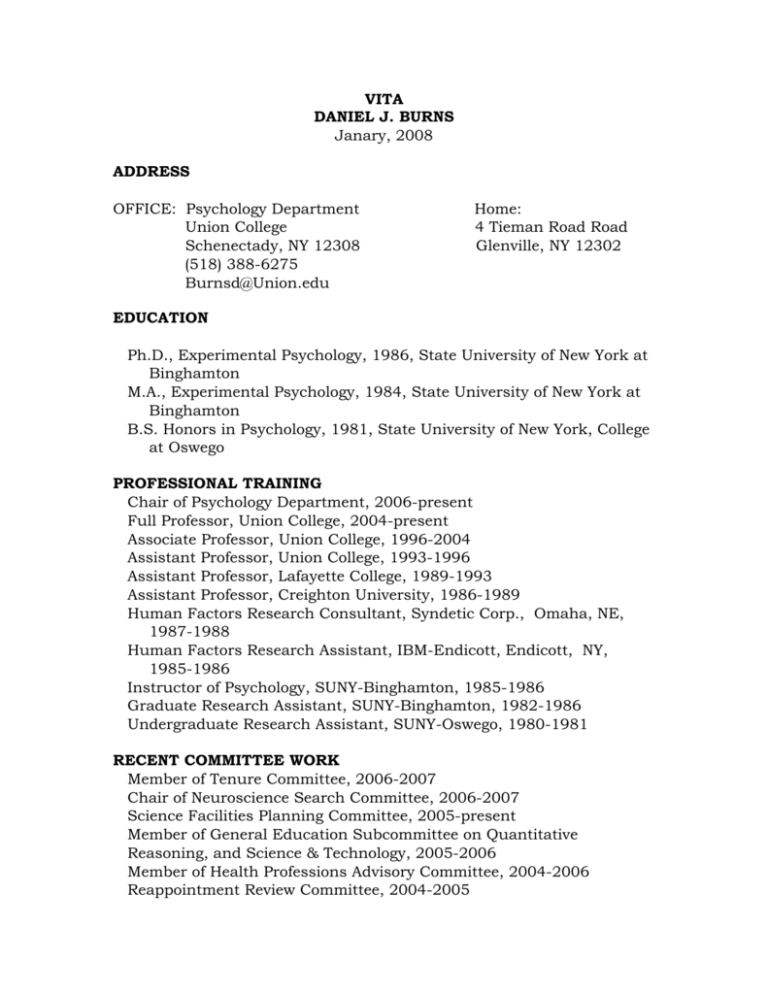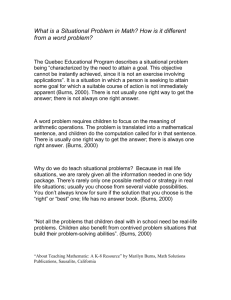Curriculum Vitae
advertisement

VITA DANIEL J. BURNS Janary, 2008 ADDRESS OFFICE: Psychology Department Union College Schenectady, NY 12308 (518) 388-6275 Burnsd@Union.edu Home: 4 Tieman Road Road Glenville, NY 12302 EDUCATION Ph.D., Experimental Psychology, 1986, State University of New York at Binghamton M.A., Experimental Psychology, 1984, State University of New York at Binghamton B.S. Honors in Psychology, 1981, State University of New York, College at Oswego PROFESSIONAL TRAINING Chair of Psychology Department, 2006-present Full Professor, Union College, 2004-present Associate Professor, Union College, 1996-2004 Assistant Professor, Union College, 1993-1996 Assistant Professor, Lafayette College, 1989-1993 Assistant Professor, Creighton University, 1986-1989 Human Factors Research Consultant, Syndetic Corp., Omaha, NE, 1987-1988 Human Factors Research Assistant, IBM-Endicott, Endicott, NY, 1985-1986 Instructor of Psychology, SUNY-Binghamton, 1985-1986 Graduate Research Assistant, SUNY-Binghamton, 1982-1986 Undergraduate Research Assistant, SUNY-Oswego, 1980-1981 RECENT COMMITTEE WORK Member of Tenure Committee, 2006-2007 Chair of Neuroscience Search Committee, 2006-2007 Science Facilities Planning Committee, 2005-present Member of General Education Subcommittee on Quantitative Reasoning, and Science & Technology, 2005-2006 Member of Health Professions Advisory Committee, 2004-2006 Reappointment Review Committee, 2004-2005 Admissions Liaison, 2003-2006 Chair of Tenure Committee, 2002-2003 Member of Tenure Committee, 1997-1998, 1999-2000 Chair of Human Subjects Internal Review Board (IRB) 1999-2002 Member of Human Subjects Internal Review Board 1998-1999 Remote College Consortium Steering Committee Member, 1997-2002 Member of Research & Grants Subcouncil, Union College, 1994-2001 PAPERS AUTHORED [ * indicates student coauthor(s)] *Burns, D.J., & Jenkins, C. L. & Dean, E. E. (2007). Falsely recalled items are rich in item-specific information. Memory & Cognition, 37, 1630-1640. *Burns, D. J., Martens, N. J., Bertoni, A. A., Sweeney, E. J., & Lividini, M. D. (2006). An item gains and losses analysis of false memories suggests critical items receive more item-specific processing than list items. Journal of Experimental Psychology: Learning, Memory, and Cognition, 32, 277-289. *Burns, D.J., & Ladd, M. V. (2006). The simultaneous learning effect: Why does simultaneous learning improve retention? American Journal of Psychology, 119, 385-405. Burns, D. J. (2006). Assessing distinctiveness: Measures of itemspecific and relational processing. In R.R. Hunt & K. Worthen (Eds.) Distinctiveness and Memory. New York: Oxford University Press. *Burns, D.J., & Hebert, T. (2005). Using cumulative recall curves to assess the extent of relational and item-specific processing. Memory, 13, 189-199. Burns, D. J. (2004). The simultaneous acquisition effect: Simultaneoustask learning inhibits memory for order. American Journal of Psychology, 117, 229-248. *Burns, D. J., & Brown, C. A. (2000). The category access measure of relational processing. Journal of Experimental Psychology: Learning, Memory, & Cognition, 26, 1057-1062. *Burns, D. J., & Gold, D. E. (1999). An analysis of item gains and losses in retroactive interference. Journal of Experimental Psychology: Learning, Memory, & Cognition, 25, 978-985. *Burns, D. J., & Schoff, K. M. (1998). Slow and steady often ties the race: The effects of item-specific and relational processing on cumulative recall. Journal of Experimental Psychology: Learning, Memory, & Cognition, 24, 1041-1051. Burns, D. J. (1996). The item-order distinction and the generation effect: The importance of order information in long-term memory. American Journal of Psychology, 109, 567-580. Burns, D. J. (1996). The bizarre imagery effect and intention to learn. Psychonomic Bulletin & Review, 3, 254-257. *Burns, D.J., Curti, E.T., & Lavin, J.C. (1993). The effects of generation on item and order retention in immediate and delayed recall. Memory & Cognition, 21, 846-852. Burns, D.J. (1993). Item gains and losses during hypermnesic recall: Implications for the Item-specific--relational information distinction. Journal of Experimental Psychology, Learning, Memory, and Cognition, 19, 163-173. Hirshman, E., & Burns, D.J. & Kuo, T.M. (1993). Examining a processing tradeoff explanation of proactive interference effects. Memory & Cognition, 21, 5-10. *Fox, S.E., & Burns, D.J. (1993). The mere exposure effect for stimuli presented below recognition threshold: A failure to replicate. Perceptual and Motor Skills, 76, 391-396. Burns, D.J. (1992). The consequences of generation. Journal of Memory and Language, 31, 615-633. Burns, D.J., & Vinchur, A.J. (1992). The effects of evaluative quizzes on test performance. Journal of Instructional Psychology, 19, 148154. Burns, D.J. (1990). The generation effect: A test between single- and multifactor theories. Journal of Experimental Psychology: Learning, Memory, and Cognition, 16, 1060-1067. Burns, D.J. (1989). Proactive Interference: An individual-item versus relational processing account. Journal of Memory and Language, 28, 345-359. Gunther, V.A.L., Grosofsky, A., Burns, D.J., & Payne, D.G. (1988). The effects of frequency and length of commands and training transfer on text editing performance. SIGCHI Bulletin, 19, 67-69. Morison, R.A., Burns, D.J., & Grosofsky, A. (1987). The legibility of print produced by the IBM 4248 impact printer as a function of band speed. IBM Technical Report. Gunther, V.A.L., Burns, D.J., & Payne, D.G. (1987). Text editing performance as a function of training with command terms of varying lengths and frequencies. SIGCHI Bulletin, 18, 57-59. Payne, D.G., Neely, J.H., & Burns, D.J. (1986). The generation effect: Further tests of the lexical activation hypothesis. Memory & Cognition, 14, 246-252. Malmi, R.A., & Burns, D.J., (1984). Task-related PI and the simultaneous acquisition retention phenomenon. American Journal of Psychology, 97, 89-95. PAPER PRESENTATIONS [ * indicates student coauthor(s)] *Dean, E., & Burns, D. J. (2007). The effect of conceptual and perceptual processing on false memories in the DRM paradigm. Eastern Psychological Association, Philadelphia, PA. *Willing, J. G., Ng, J. W., Burns, D. J. (2007). The effects of glucose ingestion on memorial processes as a function of glucoregulation. Eastern Psychological Association, Philadelphia, PA. *Lividini, M., & Burns, D.J. (2004). Relational and distinctive processing in children . Eastern Psychological Association, Washington, DC. Burns, D. J. (2003). Measures of distinctive and relational processing. Southwestern Pasychological Association, New Orleans, LA *Sweeney, E. J., Bertoni, A. A., Martens, N. J., & Burns, D. J. (2003). False memories produce more item gains across repeated tests than real memories. Eastern Psychological Association, Baltimore, MD. *Ladd, M. V., & Burns, D.J. (2001). Why does simultaneous-task learning improve recall? Eastern Psychological Association. Eastern Psychological Association, Boston, MA. *Noyes, T. L. & Burns, D.J. (2000). A cumulative recall analysisis of the effects of impression formation on free recall. Eastern Psychological Association, Baltimore, MD. *Burns, D. J., Leivent, S., & Gersten, A. (1999). Similarity does not increase proactive interference. Psychonomic Society, Los Angeles. *Gold, D. E. & Burns, D.J. (1997). Interpolated lists increase forgetting but have no effect on reminiscence. Eastern Psychological Association, Washington, D.C. *Selwyn, R., & Burns, D.J. (1997). Cumulative recall curves and distinctive processing. Eastern Psychological Association, Washington, D.C. *Burns, D.J., & Schoff, K.M. (1996). Not all cumulative recall curves are the same. Eastern Psychological Association, Philadelphia, PA. *Burns, D.J., & Pflederer, D. A. (1995). Measures of organizational and item-specific processing. Eastern Psychological Association, Boston, MA. *Hanlon, T.M., & Burns, D.J. (1995). Distinctive processing, item gains and cumulative recall curves. Eastern Psychological Association, Boston, MA. *Burns, D.J., & Hanlon, T.M. (1994). More evidence for the item gain measure of distinctive processing. Psychonomic Society, St. Louis. Burns, D.J. (1994). The role of distinctive and relational information in producing the picture superiority effect. Eastern Psychological Association, Providence, R.I. Burns, D.J. (1993). Measuring distinctive and relational processing: Item gains and Losses in hypermnesic recall. Psychonomic Society, Washington, DC. *Burns, D.J., Lavin, J.C., & Curti, E.T. (1993). The effects of generation on item and order retention in immediate and delayed recall. Eastern Psychological Association, Washington, D.C. *Fox, S.E., & Burns, D.J. (1993). The mere exposure effect for stimuli presented below recognition threshold: A failure to replicate. Eastern Psychological Association, Washington, D.C. *Burns, D.J., & Lavin, J. (1992). The influence of item-specific and relational information on performance in implicit and explicit memory tests. Eastern Psychological Association, Boston, MA. Burns, D.J. (1991). The item-specific/relational processing distinction: Analysis of cumulative recall performance. Psychonomic Society, San Francisco, CA. Burns, D.J. (1990). The negative consequences of generation. Psychonomic Society, New Orleans, LA. *Burns, D.J., Tam, L.L., & Loucks, A.A. (1990). Hypermnesia: An individual-item versus relational processing account. Eastern Psychological Association, Philadelphia, PA. *Burns, D.J., Quigley, A.A., & Fish, S.B. (1989). The generation and negative generation effects: Some tests of multifactor theories. Psychonomic Society, Atlanta, GA. Burns, D.J. (1989). Proactive interference: An individual-item versus relational processing account. Midwestern Psychological Association, Chicago, IL. *Burns, D.J., & Fish, S.B. (1989). A reversed generation effect in paired associate learning with a slow presentation rate. Midwestern Psychological Association, Chicago, IL. Burns, D.J. (1988). Item-specific information and the generation effect. Western Psychological Association, San Francisco, CA. *Burns, D.J., McCarthy, B.A., & Walter, M.J. (1988). Intra-list categorical similarity and the generation effect. Eastern Psychological Association, Buffalo, NY. *Perry, N.W., Burns, D.J., Kaleda, M., & Shimerdla, C. (1987). Children as legal witnesses: Issues of competence and credibility. Nebraska Psychological Association, Lincoln, NE. Burns, D.J., & Payne, D.G. (1986). Against all odds: Reversing the direction of a number of list-learning phenomena. Eastern Psychological Association, New York, NY. Gunther, V.A.L., Burns, D.J., & Payne, D.G. (1986). Text editing performance as a function of training with command terms of differing lengths and frequencies. Conference on Human Factors in Computer Systems (CHI), Boston, MA. Payne, D.G., & Burns, D.J. (1986). Transfer-specific interference reevaluated: When transfer-specific interference results in better retention than non-specific interference. Eastern Psychological Association, New York, NY. Waring, S., Burns, D.J., & Payne, D.G. (1986). The generation effect: Some tests of the lexical activation hypothesis. Eastern Psychological Association, New York, NY. Burns, D.J., & Malmi, R.A. (1984). Context dependent proactive interference. Eastern Psychological Association, Baltimore, MD. JOURNAL REVIEWER American Journal of Psychology Behavior Research Methods, Instrumentation, & Computers Journal of Experimental Psychology: General Journal of Experimental Psychology: Learning, Memory, and Cognition Journal of Memory and Language Memory Memory & Cognition Psychonomic Bulletin & Review Quarterly Journal of Experimental Psychology







